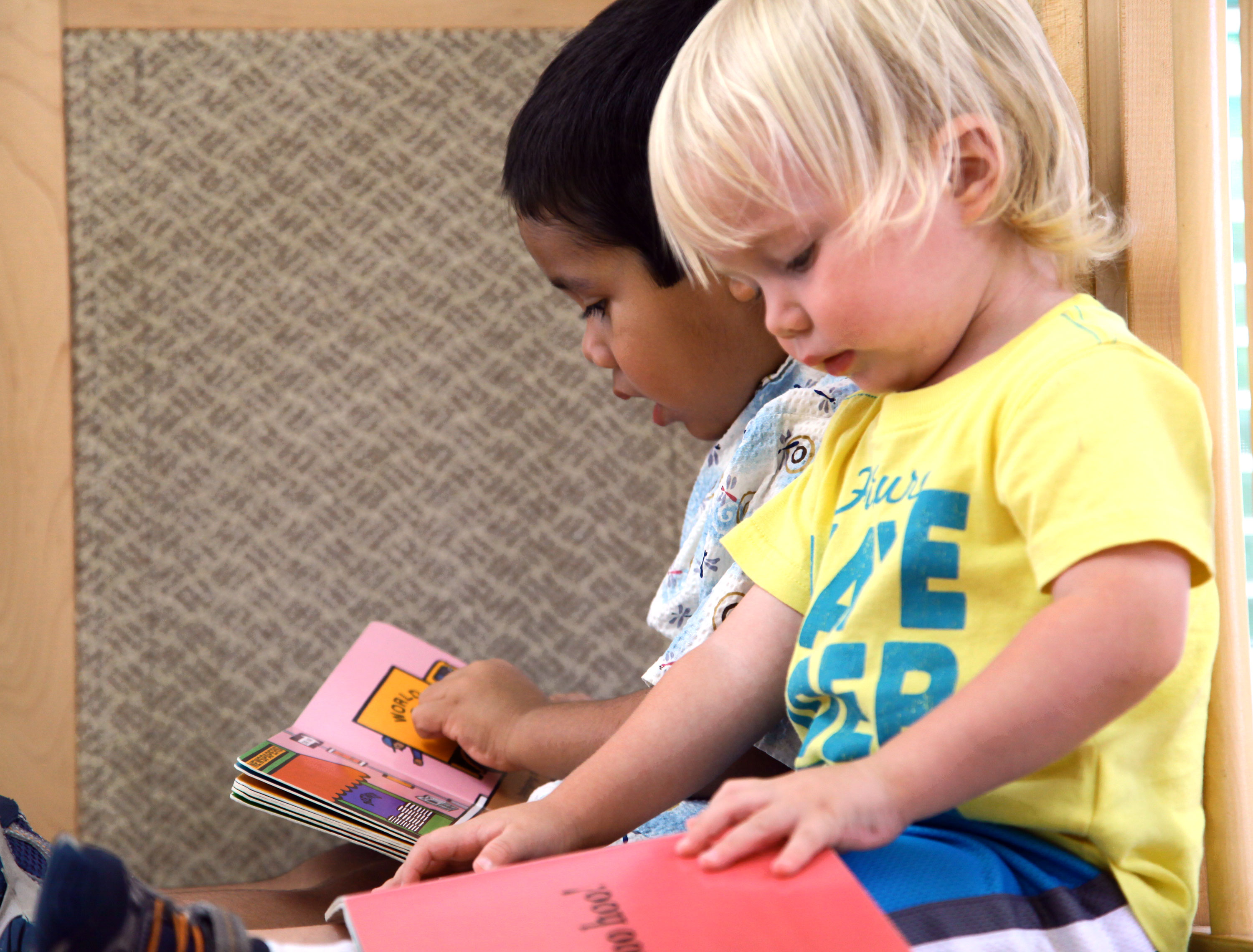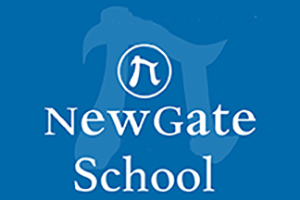Language Arts
“Children are human beings to whom respect is due, superior to us by reason of their innocence and of the greater possibilities of their future.”
—MARIA MONTESSORI

Language Arts Ages 3 to 12
Developing a Lifelong Love for the Written Word
The process of learning how to read should be as painless and as simple as learning how to speak.
We begin by placing our youngest students in classes in which the older students are already reading. All children want to “do what the big kids can do,” and as the intriguing work that absorbs the older students involves reading, there is a natural lure for the young child.
In Montessori, the process of learning to read and write almost always comes naturally and begins with a child’s first interest. She begins by learning the phonetic sounds of the alphabet, using her growing knowledge to read and write increasingly complex words and sentences. Mastery of basic skills normally develops so smoothly that students tend to exhibit a sudden “explosion into reading,” which leaves our young students, not to mention their families, beaming with pride. Once our young students have made their first breakthroughs into reading, they tend to proceed rapidly.
There is typically a quick jump from reading and writing single words to sentences and stories. At this point, we begin a systematic study of the English language: vocabulary, spelling rules, and linguistics. We begin to teach very young children the functions of grammar and sentence structure to students as young as first grade, just as they are first learning how to put words together to express themselves. This leads them to master these vital skills during a time in their lives when it is a delight, rather than a chore. Before long, they learn to write naturally and well.
During the Elementary years, we increasingly focus on the development of research and composition skills. Our students write every day, learning to organize increasingly complex ideas and information into well written stories, poems, reports, plays, and student publications.
Finally and most importantly, the key to our language arts curriculum is the quality of the things we give our children to read. Instead of insipid basal readers, we introduce them from an early age to first rate children’s books and fascinating works on science, history, geography and the arts. Literary studies continue every year thereafter through graduation.
Language Arts Scope and Sequence Ages 3 Through 6th Grade
Pre-Reading
Pre-Reading Because of our multi-age classroom design, our youngest students are constantly exposed to the older children in the class who are already reading. The total environment of the Primary classes (3 to 6 years-old) tends to create and reinforce in our young children a spontaneous interest in learning how to read. We begin to teach reading as soon as that interest is first expressed.
- Using a total immersion approach, we help the youngest children to develop a highly sophisticated vocabulary and command of the language.
- The children are taught through many early approaches to listen for and recognize the individual phonetic sounds in words.
- We introduce the children to literature by reading aloud and discussing a wide range of classic stories and poetry.
- We help our youngest students to recognize the shape and phonetic sounds of the alphabet through the sandpaper letters: a tactile alphabet.
Composition
At an early age, before handwriting has been mastered, the children compose sentences, stories, and poetry through oral dictation to adults and with the use of the moveable alphabet.
Once handwriting is fairly accomplished, the children begin to develop their composition skills. They continue to develop over the years at increasing levels of sophistication.
- Preparing written answers to simple questions.
- Composing stories to follow a picture series.
- Beginning to write stories or poems on given simple themes.
- Preparing written descriptions of science experiments.
- Preparing written reports.
- Learning how to write letters.
- By age 9, research skills and the preparation of reports become major components of the educational program. Students research areas of interest or topics that have been assigned in depth, and prepare both formal and informal, written and oral reports.
- Creative and expository composition skills continue to develop as the children advance from level to level. Students are typically asked to write on a daily basis, composing short stories, poems, plays, reports, and news articles.
Reading
- The development of the concept that written words are actual thoughts set down on paper. (This takes children much longer than most people realize.)
- Sounding out simple three or four-letter phonetic words. (Typically before age 5)
- Early exercises to practice reading and to gain the concept of a noun: labeling objects with written name tags, mastering increasingly complex words naming things that interest them, such as dinosaurs, the parts of a flower, geometric shapes, the materials in the classroom, and so on.
- Learning to recognize verbs: normally exercises in which the child reads a card with a verbal “command” printed out (such as run, sit, walk, etc.) and demonstrates his understanding by acting it out. As the child’s reading vocabulary increases, verbal commands involve full sentences and multiple steps: “Place the mat on the table and bring back a red pencil.”
- Reading specially selected or prepared small books on topics that really interest the child, such as in science, geography, nature or history.
- Interpretive reading for comprehension at ever increasing levels of difficulty, beginning in the early elementary grades and continuing until high school graduation.
- Use of the library and reference books on a daily basis for both research and pleasure.
- An introduction to the world’s classical children’s literature at increasing depth and sophistication.
Grammar
The study of grammar begins almost immediately after the child begins to read, during the sensitive period when he is spontaneously interested in language. It continues over several years until mastered. The idea is to introduce grammar to the young child as she is first learning how to put thoughts down on paper, when the process is natural and interesting, rather than waiting until the student is much older and finds the work tedious.
- We introduce our children to the function of the parts of speech one at a time through many games and exercises that isolate the one element under study. Montessori has assigned a geometric symbol to represent each element of grammar. (For example, verbs are represented by a large red circle.) The children analyze sentences by placing the symbols for the appropriate part of speech over each word.
- Once students have mastered the concrete symbols for the parts of speech, they perform more advanced exercises for several years with grammar boxes set up to allow them to analyze sentences by their parts of speech.
- Sentence analysis: simple, compound and complex sentences, clauses, verb voices, and logical analysis of all sorts of sentences are studied using many different concrete materials and exercises. This normally begins about age 5 and continues through middle school.
- Students continue their study of language from the mid–elementary years onward, reviewing as well as engaging new concepts and skills: tenses, moods, irregular verbs, person and number, the study of style, and the study of grammatical arrangements in other languages.
Handwriting
Handwriting Control of the hand in preparation for writing is developed through many exercises, including specially designed tasks in the use of the pencil. Such exercises begin with very young children and extend over several years so that mastery is gradually, but thoroughly, attained.
The young children practice making letters from the time of their first initial “explosion into writing” at age 3 or 4:
- Moveable Alphabets, made up of easily manipulated plastic letters are used for the early stages of phonetic word creation, the analysis of words, and spelling. They facilitate early reading and writing tasks during the period when young children are still not comfortable with their own writing skills. Even before the children are comfortable in their handwriting skills, they spell words, compose sentences and stories, and work on punctuation and capitalization with the moveable alphabets (Age 4-6).
- At first, by tracing letters into sand.
Later, by writing on special tilted, upright blackboards: unlined, wide-lined, and narrow-lined.
Later, by writing on special writing tablets, becoming comfortable with script. - Cursive writing (Typically around age 5)
Word Processing (Normally beginning around age 6) - Calligraphy (Whenever the child is interested, often around age 10.)
Spelling
Children begin to spell using the moveable alphabet to sound out and spell words as they are first learning to read. They ‘take dictation’ —spelling words called for by the teacher—as a daily exercise. The sequence of spelling, as with all language skills, begins much earlier than is traditional in this country, during a time when children are spontaneously interested in language. It continues throughout their education.
- Learning to sound out and spell simple phonetic words.
- Learning to recognize and spell words involving phonograms, such as ei, ai, or ough.
- Developing a first “personal” dictionary of words that they can now spell.
- Learning to recognize and spell the “puzzle words” of English: words that are non-phonetic and are not spelled as they sound.
- Studying words: involving compound words, contractions, singular–plural, masculine–feminine words, prefixes, suffixes, synonyms, antonyms, homonyms.
“Our work is not to teach, but to help the absorbent mind in its work of development.
How marvelous it would be if by our help, if by an intelligent treatment of the child, if by understanding the needs of his physical life and by feeding his intellect, we could prolong the period of functioning of the absorbent mind!”
—Maria Montessori
ASHTON ROAD
CAMPUS
Age 12 months to Grade 6
5237 Ashton Road
Sarasota, FL 34233
Ph 941-922-4949
PALMER RANCH
CAMPUS
Grades 7-12
8484 S. Tamiami Trail Sarasota, FL 34238
Ph 941-922-4949
GLOBAL
CAMPUS
Grades 7-12
Students attend at home,
from all around the world
Ph 941-922-4949
